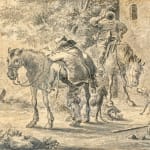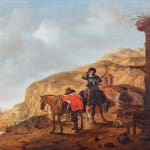Open a larger version of the following image in a popup:


Pieter Cornelisz Verbeeck (circle)
Two Horsemen next to a Tavern
oil on panel, 37 x 46 cm
Sale, Sotheby's Amsterdam, 14 May 2002, lot 78.
Pieter Cornelisz Verbeeck (Haarlem 1610 - 1654)
Two Horsemen in front of a Tavern
pen in black and brush in grey, over black chalk, on laid paper
100 x 140 mm
signed 'PVB', lower left
Pieter Cornelisz Verbeeck (circa 1610–1654) was a Dutch Golden Age painter renowned for his landscapes, genre scenes, and equine subjects. Born in Haarlem in The Netherlands, he was the son...
Pieter Cornelisz Verbeeck (circa 1610–1654) was a Dutch Golden Age painter renowned for his landscapes, genre scenes, and equine subjects. Born in Haarlem in The Netherlands, he was the son of marine painter Cornelis Verbeeck and likely received his artistic training under his father's guidance. In 1635, Verbeeck relocated to Alkmaar, where he married Agnes Groenevelt and joined the local Guild of St. Luke. According to Houbraken - who calls Verbeeck 'den Paardeschilder' - he instructed Gillis Schagen, the son of an influential Alkmaar councilman, in equine painting. By 1638, Verbeeck had moved to Utrecht. Following the death of his first wife in 1642, he returned to Haarlem and, in 1643, married Elisabeth van Beresteyn, sister of landscape painter Claes van Beresteyn. He became a member of the Haarlem Guild of St. Luke in 1645.
Verbeeck's oeuvre includes landscapes, portraits, and genre scenes, often featuring soldiers and horses. Notable works include "The resting Horseman" at the Musée Bredius in The Hague, "Cheval d'amazone sous un porche" at the Musée des Augustins in Toulouse, and "Prairie de haras" at the Musée de la Chartreuse in Douai. His compositions are characterized by dynamic movement and a keen observation of equine anatomy, reflecting his specialization in horse painting. Verbeeck's contributions to Dutch Golden Age painting are distinguished by his focus on equestrian subjects and his ability to capture the vitality of both horses and riders. His works remain significant in the study of 17th-century Dutch art, particularly in the depiction of military and equine themes.
The present charming signed sheet is a beautiful addition to Verbeecks small corpus of drawings. Depicting two horsemen in front of a tavern, it may be connected to a painted composition - likely a studio copy after Verbeeck - sold at auction a few year ago (see fig. 1), wherein the motif of the two horsemen is used.


